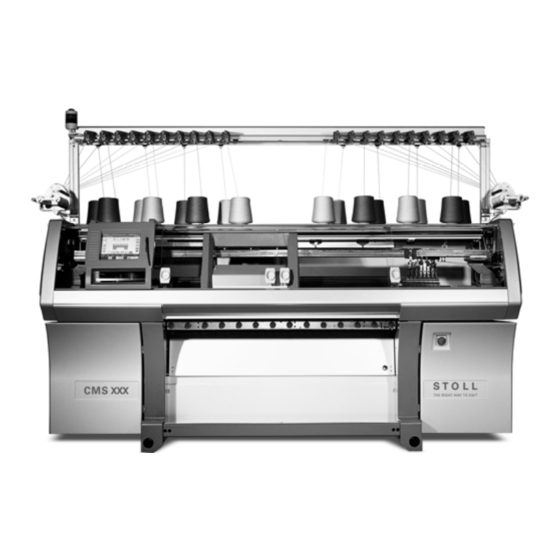
Table of Contents
Advertisement
Quick Links
CMS 933
CMS 922
CMS 830 C k&w
CMS 822
CMS 740
CMS 730 T k&w
CMS 730 S k&w
CMS 530 T
CMS 530
CMS 520 C
CMS 520
CMS 420 E
CMS 420 E multi gauge
CMS 420 E
Id no.: 244 428
Instruction manual for a
safe operation of the
knitting machine
Type
769
770
573
574
572
586
554
585
566
570
567
579
577
575
Computer type
Component type
OKC
000 - 004
OKC
000 - 004
OKC
000 - 004
OKC
000 - 005
OKC
000 - 004
OKC
000 - 004
OKC
000 - 004
OKC
000 - 004
OKC
000 - 004
OKC
000 - 004
OKC
000 - 004
OKC
000 - 002
OKC
000 - 001
OKC
000 - 001
US
Advertisement
Table of Contents

Summarization of Contents
Safety instructions
1.1 Proper use
Details the correct and intended application of the knitting machine according to industry standards and regulations.
1.2 Organizational measures
Outlines essential organizational procedures for safe machine operation, including manual accessibility and regulatory compliance.
1.3 Personnel qualifications and selection
Defines necessary qualifications and selection criteria for personnel operating and maintaining the knitting machine.
1.3.1 Personnel qualification
Specifies required qualifications for electricians, mechanics, and knitting experts for safe machine operation.
1.3.2 Selection of personnel
Details responsibilities and minimum personnel requirements for activities like assembly, operation, and maintenance.
1.4 Warning
Explains various warning symbols, their meanings, and placement on the machine and in documentation.
1.5 General safety instructions
Provides essential safety guidelines covering mechanical parts, electrical energy, operating materials, and other hazards.
1.6 Safety instructions for the individual Operation Phases
Covers safety precautions specific to operational phases like transport, lubrication, electrical connection, data exchange, and production.
Electrical data of the machine
2.1 Dimensions and weights
Presents physical dimensions and weight specifications for various knitting machine models, including dynamic load data.
2.2 Electrical data
Details electrical specifications like supply voltage, phases, rated current, and power consumption for different machine types.
2.3 Electrical data (component type 000 and 001)
Provides specific electrical connection data, including voltage and current ratings, for component types 000 and 001.
2.4 Gauge ranges
Lists available gauge sizes and corresponding needle numbers for different knitting machine models.
2.5 Operating conditions
Defines recommended ambient temperature, humidity, and installation environment for optimal machine operation.
2.6 Storage conditions
Outlines necessary cleaning, lubrication, and protective measures for storing the knitting machine for extended periods.
2.7 Noise emissions
Reports noise emission levels for the knitting machine series, adhering to relevant ISO standards.
Main components of the knitting machine
3.1 Front side
Identifies and illustrates main components on the front of the knitting machine, including carriage and control panels.
3.2 Lateral view (right)
Highlights key components visible from the right lateral side, such as yarn feeding and control devices.
3.3 Rear side
Illustrates and names components on the rear side, including control units and drives.
3.4 Optical and acoustic Signal elements
Explains signal lamps, touch screens, and horns for machine status indication and error reporting.
Assembly and setting up
4.1 Preparing assembly
Covers initial setup steps, including preparing the installation location and gathering necessary tools.
4.1.1 Preparing installation location
Specifies required conditions for the installation site: flatness, firmness, and adequate space.
4.1.2 Having tools and aids ready
Lists essential tools and accessories for machine assembly and setup, such as spanners and levels.
4.1.3 Transporting machine to installation location
Provides instructions on safely transporting the knitting machine to its final installation site.
4.1.4 Unpacking knitting machine
Details unpacking procedures, including removing packaging materials and accessory boxes.
4.2 Assembling machine
Guides through assembling the knitting machine, including lifting, positioning, and securing it.
4.2.1 Putting up knitting machine
Explains how to lift and position the knitting machine onto its designated location or transport surface.
4.2.2 Connect the knitting machine
Provides instructions for connecting the knitting machine to the main power supply, emphasizing safety precautions.
4.2.3 Connect the knitting machine (component types 000 and 001)
Details electrical connection procedures for specific component types, including transformer and motor switch settings.
4.2.4 Aligning knitting machine
Describes how to properly align the knitting machine using levels and grub screws for accurate operation.
4.3 Mounting yarn feeding and control device
Guides installation of the yarn feeding and control system, including the yarn control device and signal lamp.
4.3.1 Mount the yarn control device
Details steps for mounting the yarn control device, ensuring correct spacing and positioning.
4.3.2 Mounting signal lamp
Explains how to connect and securely mount the signal lamp onto the machine's support structure.
4.4 Glue on measuring tape
Instructs on applying the measuring tape for checking fabric length, typically positioned above the engaging rod.
4.5 Switching on machine
Describes powering on the knitting machine and initiating the startup sequence via the main switch.
4.6 How to bring the carriage to an immediate standstill
Outlines immediate actions to stop carriage movement, using engaging rod or cover hoods.
4.7 Checking safety equipment
Details daily checks for all safety devices, including engaging rods, covers, and emergency stop switches.




Need help?
Do you have a question about the 572 and is the answer not in the manual?
Questions and answers